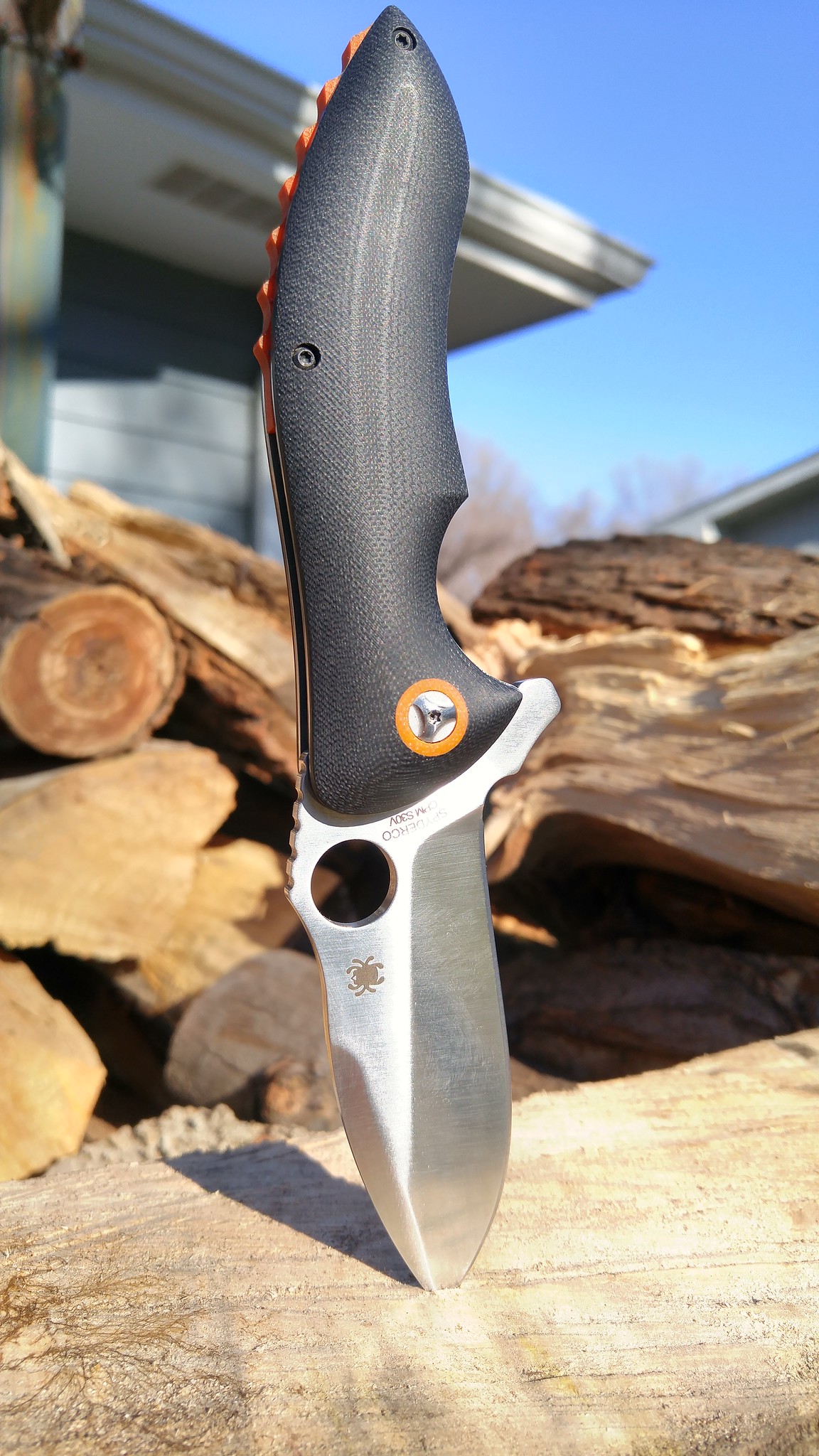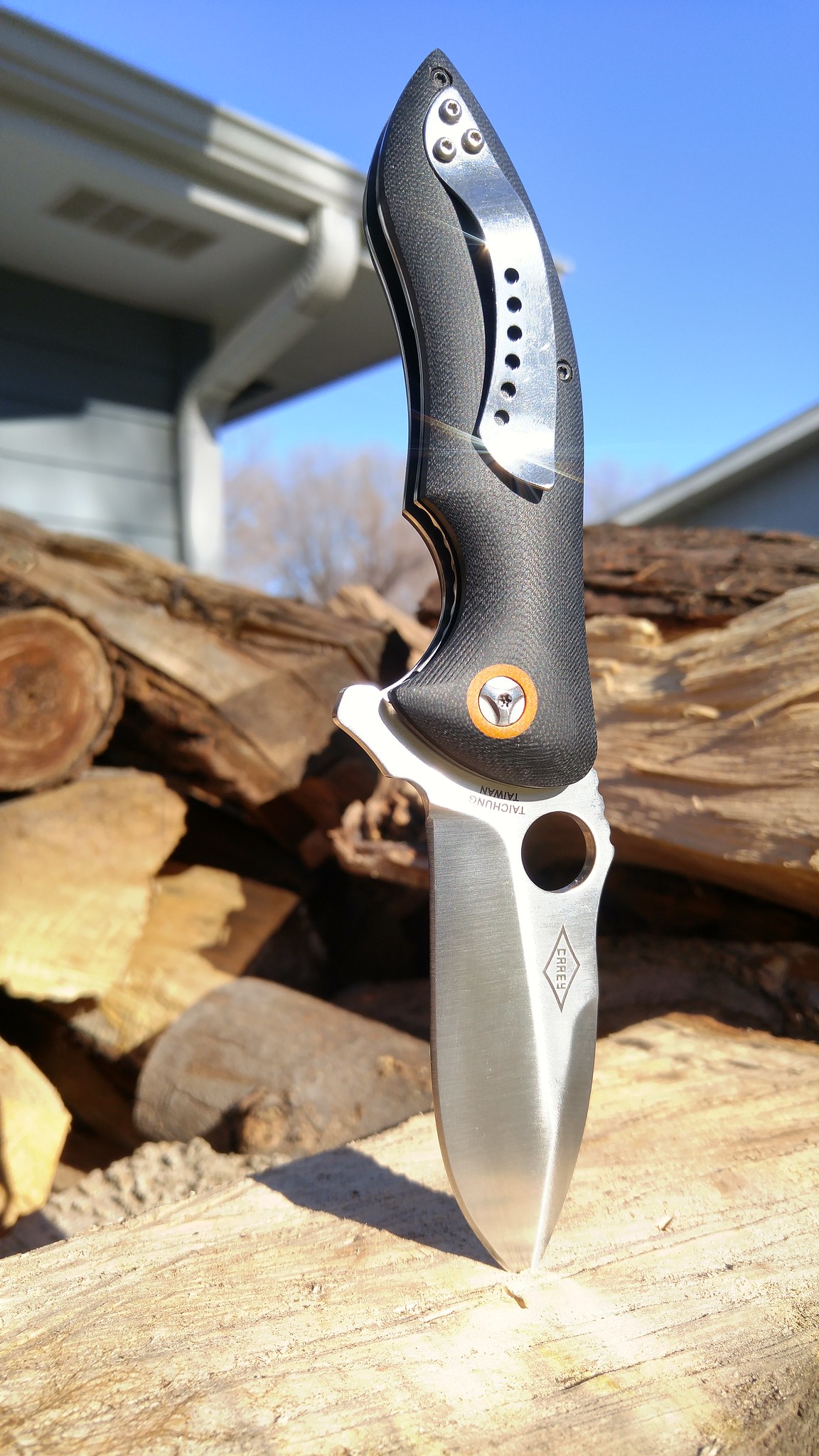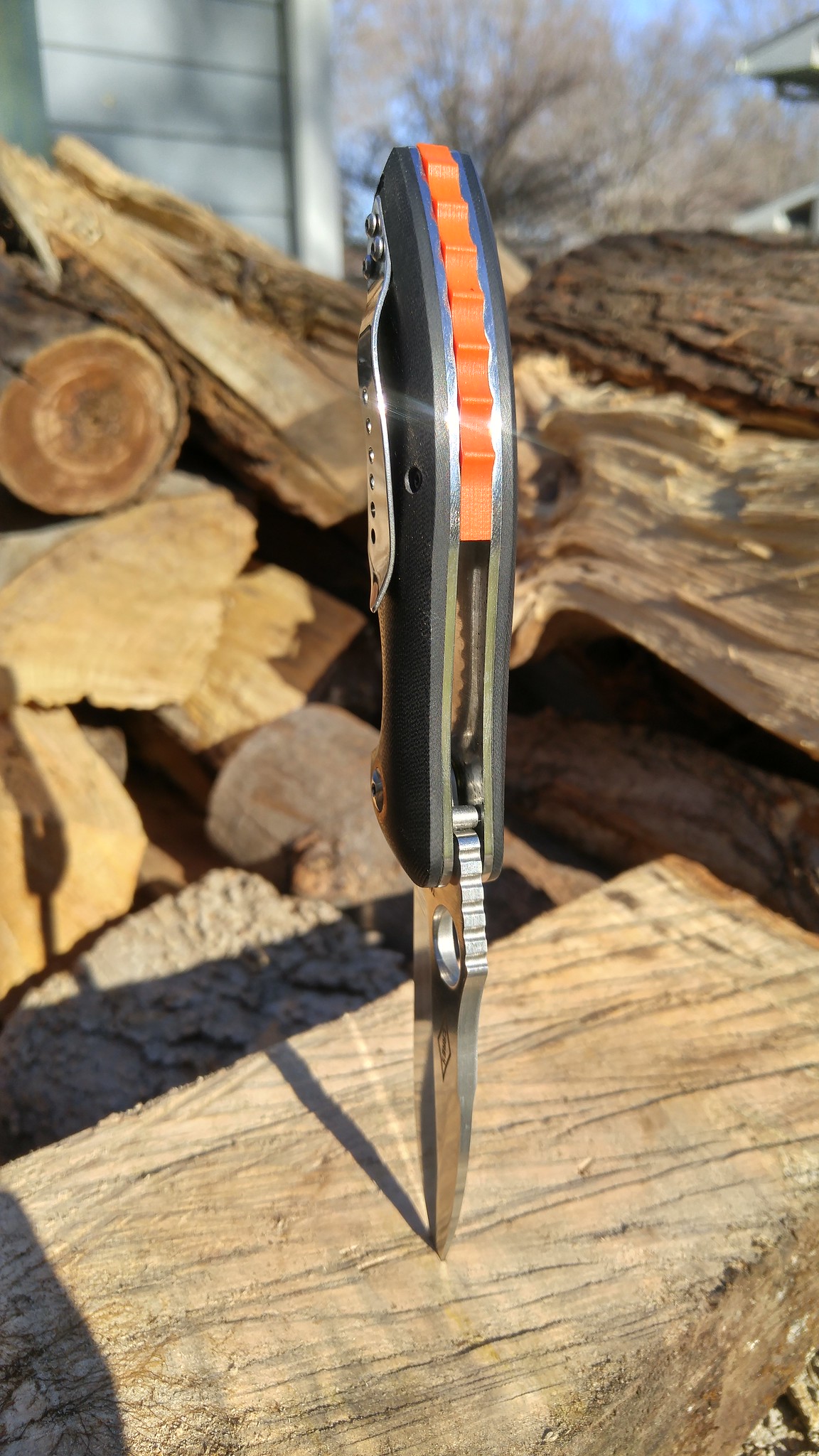So, a few people have asked me to review this knife (in this thread about budget knives ), presumably because they are as intrigued by it as I was. I’ll do my best to keep this fairly well organized, and rambling to a minimum, but I make no promises. I’ll have some pictures in the review of areas of interest, but it’s a lot more time consuming to take high quality pictures and get them uploaded, so it’s good cell phone pics unless someone has a better reason to need higher resolution than eye candy. Both I and my cousin really gave these knives the hairy eyeball. Some things I’m going to bring up might seem like hash criticisms of a $23 knife, but just because I mention it doesn’t mean it’s a big deal to the function of the knife. I’m reporting things as I see them, and not passing judgement unless it effects the safety of the knife, or significantly effects use.
Link to Aliexpress store where I bought my 3 knives from.
Aliexpress link, non-aff
**Description from Web Store:** Full length: 212mm **** Blade length: 84mm **** Handle length: 125mm **** Blade width: 31mm **** Blade thickness: 3.8mm **** Blade material: S30v **** Weight: 250g (including packaging) **** Hardness: 58HRC **** Surface: sanding **** Handle material: Black G10 + red G10. **(My eyes measure black and orange ;) , definitely not red)** Other: Folding ****
Dis-assembled view from the manufacturer:
**My take on provided specs, and other possibly useful dimensions**
The dimensional accuracy of the knife to the stated specs is reasonably close, the handle material is correct if you don’t include color, but the blade steel is 99% likely to NOT be CPM S30V.
Some measurements that they don’t provide that can be useful are as follows.
Primary Grind Type: Flat Ground at approximately 4.7° per side
I measured some variation of 4.3-4.8°. A shallower angle would produce a better cutting knife, in my opinion a real S30V knife at 58Rc doesn’t need that wide of an angle in a knife like this. It’s not a pry bar, and at 58Rc edge damage should happen well before blade fracture. I think if it’s compared to a knife with 3-3.5° of bevel per side, this knife would feel a bit harder to push through the cut, making fatigue set in faster if used for long periods. The effect would become more noticeable as the material being cut gets thicker. Since I don’t think this is S30V, the girth could be useful since the steel and heat treating quality are uncertain.
Blade Tip Thickness: 0.95mm directly behind sharpened edge. Should make for a pretty tough tip. The knives I make from CPM-3V are around 0.40-0.60mm at the tip depending on intended use, and the ones from CPM-S90V run 0.40-1mm depending on use.
Usable Handle Length: 104.5mm
This is measured from the front of the index finger cutout to the back end of the knife, and gives a better idea how it will fit in your hand than the overall handle length.
Handle Thickness: 21.32mm(G10 to G10), 24.3mm (G10 to outside of clip), 22.35mm (at pivot bolt heads)
Fasteners: Pivot- T8 / Handle- T6 / Clip- T6
Pocket Clip Clearance: 2.5mm
Clip Carry: (RH) tip up
My Pictures




**Differences between the 3**
Slight variations in flippability. 2 are good, one is a bit sluggish. Once the sluggish one was sprayed with good lube and air it sped right up.
Tip centering between the liners, 2 very good, one slightly off center at the tip. All three are well centered on the pivot end .
Tip height closed. One knife sits lower in the handle than the other two. This knife also has less deep jimping than the other two. See the picture.
Edge deburring varied greatly along all the edges (not the cutting edge) of the various knives. Some well rounded over, some fairly sharp still.

**Impressions of Build Quality**
Blade
Blade grinding looks pretty good, though symmetry isn’t great. For example the point made by the intersection of the primary bevel, swedge grind, and flat face doesn’t line up from side to side. I suspect this isn’t present on the 12x(!!!) more expensive Spyderco Rubicon. Also, the edges of the grind where the primary bevel and swedge meet the flat face doesn’t have the usual Spyderco crispness. This is, I believe, the evidence that points to being hit with a polishing wheel after the grinding was done. Personally I don’t find flaws like these to impact the performance of most knives, and in fact prefer the primary bevel to flats edge on my knives for use (as opposed to shelf queens) to be slightly rounded. The back edges of the blade have been deburred, but not aggressively so. The flipper portion is noticeably more rounded over on the edges. If I had my way, the edges on the back side of the blade would be rounded over the same amount, they are a bit sharp for my taste in a folder (and a lot sharp for my taste in a bush-craft or hard use knife). The Spyderco hole is similar to the back edge, and in that respect similar to real Spyderco’s, fairly crisp, but unlikely to maim you.
Laser etching is a bit of a letdown. Depth and darkness varies. Sanrenmu and Ganzo both have this down much better on all of the examples I have. It’s not a dealbreaker, but anyone who is familiar with Spyderco quality will likely be able to spot it as a fake if your example has the same variability as mine. Interestingly the blade is marked with the Spyderco logo, the Spyderco name, CPM S30V, CAREY, and TAICHUNG TAIWAN. I’m sure we’re all aware the Spyderco markings aren’t legitimate which means the CAREY and TAICHUNG TAIWAN markings aren’t either, the general wisdom of the internet (and common sense) suggests the CPM S30V isn’t either. The WWW rumor mill says it’s 440C. Since I don’t have a laser spectrometer, I’ll go with my gut that they’re probably right, it’s likely 440C or 9Cr18MoV. I’ve purchased CPM S30V, CPM S35VN, CPM S90V, and CPM S110V directly from the US distributor, I know what it costs to buy CPM steel, and there is no way that this Knife is made from S30V for $23.
The variation in the tip position between the knives, and the difference in jimping depth suggests that these are held in a fixture for final edge machining that has some play in it, or they have a guy messing with offsets who shouldn’t be.
Regardless, after a shot of lubricant all three examples flipped smoothly, so the variations of the machining don’t seem to effect the function.
**Handle**
The handle is the part of this knife that stands out to me. It’s well executed in almost every way, with only a few flaws. The surface texture of the G10 is superb. Grippy enough without being so aggressive that it’s going to tear up the edge of your pocket. Like the blade it suffers from some symmetry issues, but like the blade, you’re looking for them before you notice them. Quick inspection or handling generally won’t be enough to notice them. There’s a bit of fuzz around the some of the smaller screw holes on the handle sides, something I’ve noticed on many of the other budget knives with G10 or Micarta handles. The liners and the G10 sides also don’t match perfectly. There is a slight mismatch either in size or placement that leaves a few thousandths of the liner exposed on one side. It’s not enough to make it uncomfortable, or notice from more than a small distance away, but it’s another sign of less than perfect fit and finish.
I wish there was 1 more T6 screw holding the sides to the orange G10 spacer. The screws are small enough that it seems like a potential weakness to only have two on each side, even with the reasonably sized pivot holding things together on the front end. Speaking of the pivot on the front end. The center of it is a T8, so don’t be concerned by the tri-lobe design, it’s not some weird proprietary fastener.
The liners appear to be stamped stainless steel blanks which are then machined with the relief, scallops, ball detent, and tapped holes. I’m a bit unimpressed by the liners, and I can’t justify why. I could be wrong, but they don’t inspire confidence in me. After a fairly small amount of chipping away at a piece of wood with a moderate to fair amount of force the lockbar has already moved past 100% engagement, and the pivot needed to be tightened slightly. Maybe that’s just the lockbar bedding in, in which case all is well, as it still has plenty of room to wear and still engage. The slightly bigger worry is whether the pivot will continue to need tightening, as I’m already concerned about the amount of pressure on the pivot bearings.
**Clip**
Clip is good; strong, springy, and has enough of a curl on the end that it’s not to difficult to slip over the edge of your pants pocket, even thick pants like Carhartt’s. The edges of the clips are extremely well rounded, and the surface is polished. There’s zero possibility of cutting your finger or pants on it. As stated earlier it doesn’t have any provisions for positions besides tip up carry (RH pocket friendly). For those of us lucky enough to be righties it’s the perfect carry for quick deployment (some may disagree, that’s fine, I don’t mind them being wrong ![]() ). It sits in a recessed flat that keeps its profile low. I’ve mentioned before that often clips are an area where many cheap Chinese knives fall short in my opinion. Since this is such a critical part of the functionality of a pocket knife it’s a real letdown when everything about a knife is great except for the clip. This knife is a welcome exception, I have very little bad to say about the clip.
). It sits in a recessed flat that keeps its profile low. I’ve mentioned before that often clips are an area where many cheap Chinese knives fall short in my opinion. Since this is such a critical part of the functionality of a pocket knife it’s a real letdown when everything about a knife is great except for the clip. This knife is a welcome exception, I have very little bad to say about the clip.
**Sharpening, Edge Retention, and use tests**
Sharpness out of the box
Requires some pressure and speed to get the knife to shave arm hair. Cuts paper ok, but grain direction of the paper has a big effect on its ability to cut cleanly. No chips, obviously rolled edges, or burn marks on the steel were visible in the three examples. The edge is slightly toothy, and should be a good place to start for general tasks, especially those that may involve fibrous materials.
On a scale of 0-10, with 0 being a butter knife, 5 being able to just start to cut arm hair, and 10 being a razor blade, this one is a 5. It is fine for general tasks, and for many people is about where most knives will spend their lives, between a 6 and a 4. For my knives I tend to try and keep them around 9-6 depending on the type of knife, again, its just a product of having been spoiled by really sharp knives and having the tools to keep mine very sharp pretty easily.
**Cut Capability**
Some people mistakenly associate this with edge retention, sharpness (has some effect, but not none if comparing knives of reasonably equal sharpness), or steel quality; but really it’s all about geometry. Higher quality steels will perform longer, or withstand more abuse, but when it comes to how easy (I.E. amount of force) it is to cut something thicker than paper with a knife it’s ALL about geometry. One thing that many people often overlook is the thickness of the blade and the angle of the primary grind. I mentioned above that this knife has a pretty steep (compared to what I make) 4.7° per side or so. Combined with a behind the edge thickness of 1.05mm compared to the 0.90mm of the Spyderco (which has a similar primary grind angle), and the 0.38mm of the knife I made (with approximately a 3° primary grind) in the picture, and you can see the effect that thickness behind the edge makes going from 1.05mm to 0.90mm. The real Spyderco cut a bit deeper with fewer splits in the wood it is peeling off because its a smaller wedge. Cut the thickness behind the edge in half and reduce the primary grind angle to 2/3 of the other two knives and you get what you see with the custom knife. It cuts significantly deeper with hardly any curl to the chip it’s making because of how small the wedge is compared to the other two. If you ever want to know how bad most knives are, pick up a $10-15 wood carving knife and prepare to have your mind blown for how easy it can be to cut deeply into wood with the right geometry. Unfortunately knives that are general purpose like your average folder or fixed blade compromises that cutting capability for strength so that they don’t have customers complaining about broken blades and chipped edges when they choose to use them ad a screwdriver, prybar, etc.

I’d rate this knife as slightly below average for cutting capability stock. It’s not going to be much different than other knives with similar proportions, but compared to something really designed to cut easily it does fall short. If you are used to thick knives you will find it to be similar to what you are used to, but I have been spoiled on knives with very good cutting capability, so the two ends of my scale that I rate them on may be different than yours.
**Edge Retention**
To Be Continued……
**Sharpening Impressions**
To Be Continued……
**Final thoughts, and things I’d change about it**
To Be Continued……